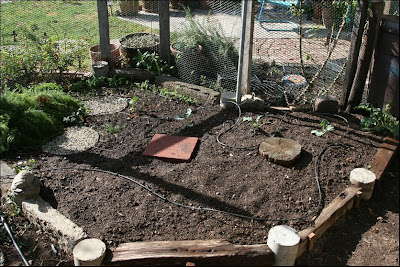
This is one of our backyard gardens; it’s actually the original garden that we started probably 15 years years ago. The fence is to keep the dogs out …wish we could say the same for the cats .

And this is one of the reasons we feel we are out-growing our little home garden. We have only one compost pile which we add to all year long, grass clippings, vegetable waste from kitchen, yard cleanups, urine (icky but a very good fertilizer …can actually be put straight into the garden diluted with water at a 10/1 ratio). Unfortunately, when we need to use the compost, the good stuff is at the bottom of a very large pile. We started a second pile this year with the intention of only adding to that pile, letting the other decompose so it would be ready to use next summer. Unfortunately, our budget once again reared it’s ugly head and we decided we needed the wonderful compost that was surely resting at the bottom of our original pile, plus the 2nd pile was taking up valuable garden space, so……in we go.

The top part of the pile had to be move temporarily, and then as we got down to the brown, dirt looking stuff we started sifting. We made a sifter thingie (technical term) out of heavy duty wire mesh that we folded up about 3 inches on the sides. The compost is then shoveled into the sifter, hand sifted and the sticks and bigger pieces remain to be thrown back into the pile when the box is emptied. It’s a long, strenuous process and though we ended up with probably $100 worth of rich organic compost, a change must be made. Ideally, we will be looking at building 3 bins in the new garden and moving the compost 3 times a year. This will aerate the piles and provide a point where two piles are not being added to, allowing them to decompose. No sifting should be necessary in the 3-bin system; we are simply too old for this kind of effort.

ps. if you were wondering about the
No allo written on the side of the compost bin…we used the wood from an old fort that our sons had built and painted….
No girls allowed.



















